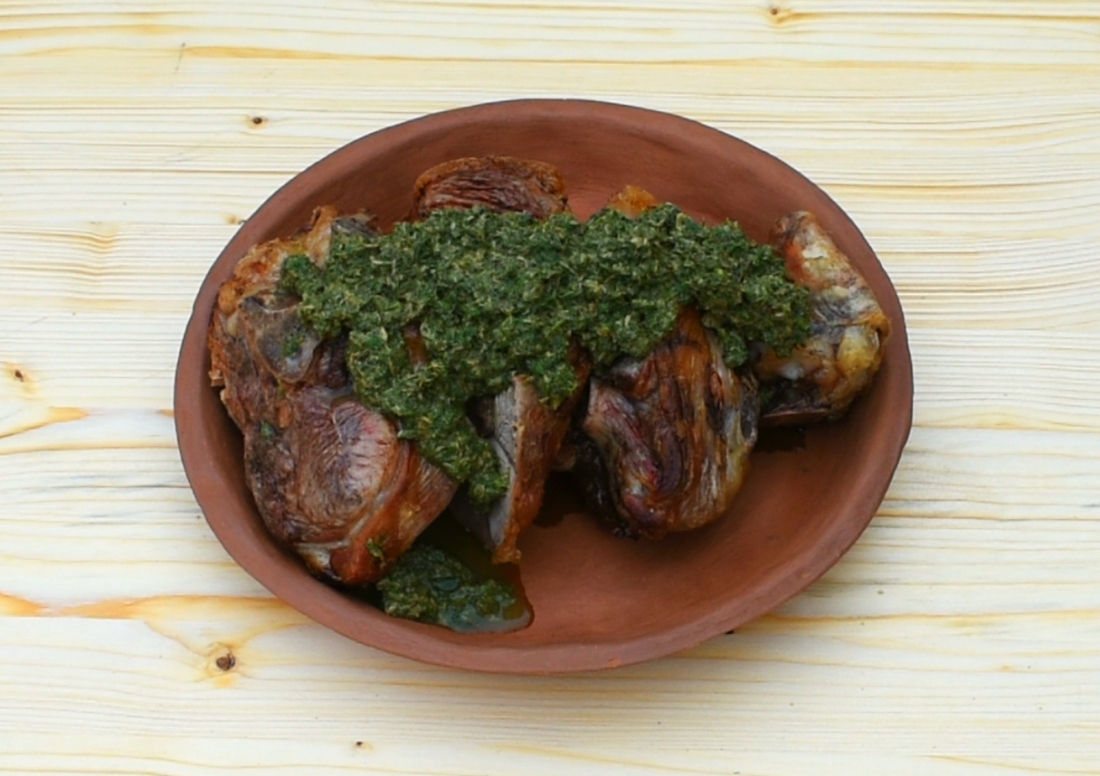We present today a delicious roast lamb coated with an aromatic green sauce made with spices and many fresh herbs. The source is an anonymous 14th-century cookbook, generally called Anonimo Veneziano.
The author gives us only the recipe for the sauce and suggests using it for preparing mutton or goat, but it will be delicious paired with any kind of fat meat, such as pork or beef, boiled or roasted.
We thought it could be a perfect Easter recipe for the presence of so many aromatic fresh herbs, so we chose to prepare lamb with the herbs of our garden.
Below you will find the original recipe and the English translation.
Enjoy your meal!
Ingredients
1 leg of lamb
lard or lardo or extra virgin olive oil
white wine vinegar
spices (black pepper, cloves, cinnamon)
fresh herbs (sage, rosemary, mint, and parsley)
other optional herbs (lesser calamint, pennyroyal, oregano, and marjoram)
Method
Before roasting the lamb, cut a little piece of meat. It will cook faster than the whole leg, and you will use it to prepare the sauce.
Coat the meat with a thin layer of lard, then put it in the oven.
When the slice of meat you cut before is ready, prepare the sauce. Grind in the mortar cinnamon, black pepper, and cloves to taste. Then, mince finely the herbs and add them in the mortar, pounding all together with a pinch of coarse sea salt. Mince the slice of meat and mix it with the sauce, diluting with vinegar.
When the roasted lamb is ready, plate it coated with the sauce and serve.
Note about the ingredients
For this recipe, is necessary using only fresh herbs. The mandatory herbs are parsley, sage, mint, and rosemary, but the author recommends adding any good herb available to the cook. You can use fennel, basil, cilantro, thyme, savory, and other fresh herbs of the Old World. The outcome of our sauce was directed toward a mint flavor, but we suggest choosing the herbs you prefer according to your taste.
The author advises the reader to use the best vinegar you can get.
Thought the source doesn’t give us directions about how to prepare the meat, we used one of the most common medieval ways, coating the lamb with lard to obtain a juicy and moist roast. You can use also pounded lardo or extra virgin olive oil instead to taste.
Original recipe
Salsa bona a carne de castron o de capreto.
La meiore salsa che fare se pò a questa carne alesse o rosto. Toy de la carne magra ben cocta e ben batuta e pesta in lo mortaro cum arquante cime de petrosemolo e menta e salvia e rosmarino e altre bone herbe che tu poi avere e maxenale con questa carne e mitige cenamo e garofali e pever e distempera questa salsa con el piú fino aceto che tu ay.
Translation
Good sauce for mutton or goat.
The best sauce you can prepare for this meat either boiled or roasted. Take lean meat well cooked and pounded and grind in the mortar with many parsley leaves, mint, sage, and rosemary, and other good herbs you have. Mix them with the meat and add cinnamon, cloves, and pepper, and dilute this sauce with the best vinegar you can get.
Recipes
Medieval Lamb Stew VIDEO
Medieval Quails with Sumac VIDEO
Medieval Sweet and Sour Sardines VIDEO
Medieval Trouts with Green Sauce VIDEO
Medieval Clams VIDEO
Medieval Sea Bream VIDEO


